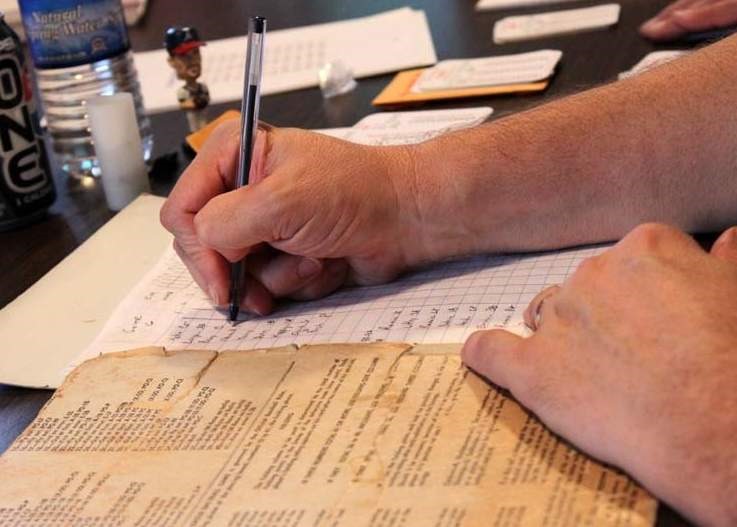For those new to APBA Baseball, knowing what pitching grades stop which hit numbers can be a little daunting without having to look it up every time. It would be handy to know them on the fly. And when making a managerial decision, it can be nice to know ahead of time what the chances of getting a hit against the opposing pitcher.
It’s not as simple as ‘B pitchers stop eights and C pitchers stop nines’.
Heck, I’ve been playing this game for decades and sometimes I need to verify the results on some of the boards.
So, is there a good way to instill in your mind the numbers that are stopped by graded pitchers? The APBA Baseball game likes to throw us curve balls (pun intended) occasionally but let’s start with a baseline.
- D pitchers don’t stop any hits (this is always true)
- C pitchers generally stop result number 9
- B pitchers generally stop result number 8
- A pitchers generally stop result numbers 8 and 9
These statements are true except for when they aren’t.
The base situations in which the above indeed holds true are:
- Bases Empty
- Runner on Second
- Runners on First and Second
- Bases Loaded
On certain base situations, does APBA throw us those curve balls. That leaves us plenty of outliers to memorize. Let’s take a look at each one.
Runner on First
It doesn’t take long before find one of those curve balls. With a runner on first, there is a small one and it probably frustrates the opposing team. The only change is against an A pitcher. A player result 9 will be a hit and in exchange, a 7 will be a groundout.
- 7—Out at 1st; runner to 2nd; A-3B PO-1B
- 9—SINGLE; beats out infield hit; runner to 2nd
Honestly, I could never figure out the logic behind this from the game’s perspective.
Runner on Third
Like runner on first, this situation, this has one main change but it’s a big one. You might want to bring in your A* to get the out with a runner on third. But watch out… you sometimes won’t always like the results.
- 8—No Change
Yes, against an A pitcher, an 8 is a hit. Hit numbers 7s and 9s are outs, though.
It’s worth mentioning that a 10 is a hit and a steal similar to Runner on First (Bases Loaded is the only other one).
Runners on First and Third
Oh boy, this one is a doozy. For most base situations, even ones with these types of outliers, there seem to be some sort of pattern. Not with Runners on First and Third. Which grades stop what hit numbers seem to randomly placed on the board.
First, a C pitcher doesn’t stop 9s; instead he will stop an 8:
- 8—Fly out; one runner scores; other holds; PO-CF
Now you would think the B pitcher would play along and stop the 9. Nope. Both the 8 and 9 result numbers are singles as well as the 10. To its credit, the B pitcher does get the almighty 7:
- 7—Fly out; one runner scores; other holds; PO-CF
With runners on first and third, I like to think of the A pitcher’s results as the mirror image of the B’s. While the A allows the 7 through, it stops the 8, 9 and even the 10.
- 8—Fly out; one runner scores; other holds; PO-RF
- 9—Fly out; one runner; scores other holds; PO-LF
- 10—Fly out; one runner scores; other holds; PO-RF
This isn’t grade-related but First and Third is only base situation where the batter does not steal a base after a hit on a player result 11. For sure, the Runners on First and Third chart is a very interesting one for many different reasons.
Runners on Second and Third
Runners on Second and Third is another odd one. In addition to stopping the 9, a grade C pitcher will also turn a 10 into a base-advancing fly out.
- 10—Fly out; runners advance one base; PO-CF
Grade B pitchers stop both 8s and 9s. They do allow 7s and 10s to sneak through for hits, though:
- 8—Fly out; runners advance one base; PO-CF
- 9—Fly out; runners advance 1 base; PO-RF; * SO; PO-C
Finally, grade A pitchers are similar to the Runner on Third chart in that allow 8s but stop the 7s and 9s. However, they also stop the 10.
- 7—Fly out; one runner scores; other holds; PO-LF
- 9—Fly out; PO-CF; 1 scores; other holds; * SO; PO-C
- 10—Fly out; PO-RF; 1 scores; other holds; * SO; PO-C
A few closing notes
It’s worth mentioning that even those outs that are stopped from being hits by graded pitchers are at least productive outs with less than two outs. That is, they move a runner along to the next base. When there are more than one runner on base, check to see how many move. On occasion, only one runner will move up.
With two outs, some grades will convert fly outs to strikeouts in certain base situations. This is happens occasionally with grade A pitchers and occurs once with grade B pitchers.
I haven’t addressed the hit and run chart in this article. The APBA pitching grade system does come into play here. I address the quirks of it in Tuesday Tip: Using the Hit and Run play which I wrote a few weeks ago.
I don’t know if this has been helpful for any of you. For me personally, it took me a long time to remember that A pitchers let 8s through as hits and inconveniently, the opposing batter usually had four of them.




